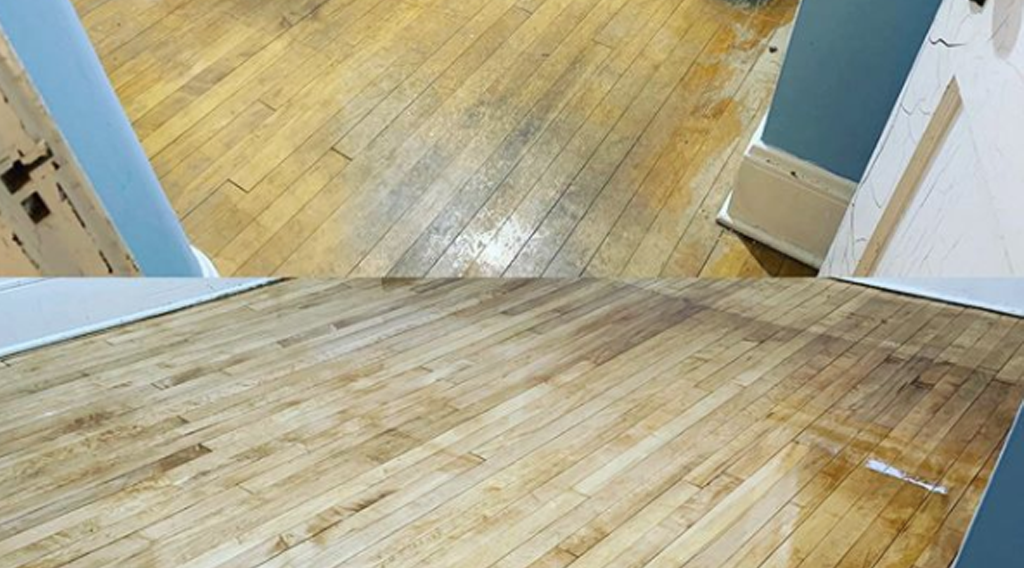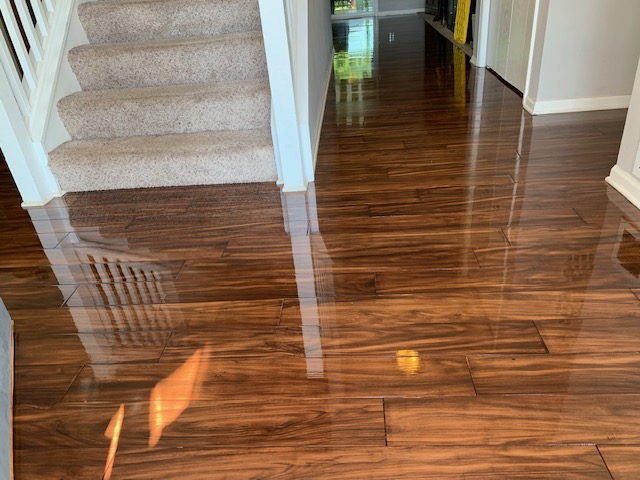Peeling Hardwood Floor Finish

Is the polyurethane on your floors starting to peel? What can you do about it?
If you’ve noticed that the polyurethane finish on your hardwood floors is beginning to peel or chip, you may be wondering what went wrong and how to fix it. At Choice Hardwoods, we often encounter this issue, and there are several common causes behind it. Fortunately, depending on the severity of the peeling, there are solutions that can restore your floors to their former beauty. In this article, we’ll break down the causes of peeling polyurethane and outline the steps you can take to address the problem.
Why Is Polyurethane Peeling on My Hardwood Floors?
Polyurethane is a popular finish for hardwood floors because it provides a durable, long-lasting protective layer that enhances the beauty of the wood. However, like any finish, it can experience issues over time, including peeling. Let’s explore some of the most common reasons why polyurethane might begin to peel:
1. Improper Surface Preparation
The most common cause of peeling polyurethane is inadequate preparation before the finish is applied. When a floor isn’t properly cleaned, sanded, or screened before applying polyurethane, the finish doesn’t adhere properly to the wood surface. For instance, if the floors have dust, dirt, or oils on them, the polyurethane will have difficulty bonding, leading to peeling.
At Choice Hardwoods, we make sure to thoroughly clean and screen the floors before applying the finish. The screening process involves lightly sanding the surface to create a smooth, clean texture that allows the new finish to adhere properly. Without this crucial step, the finish can easily peel over time.
2. Using Cheap or Outdated Polyurethane Products
The quality of the polyurethane finish used can also impact its longevity. Cheaper, lower-quality finishes may not provide the durability or proper adhesion needed for a lasting bond. Over time, these lower-quality finishes can break down more quickly, leading to peeling or chipping.
Additionally, using an outdated or improperly stored polyurethane can cause issues. Polyurethane products have a shelf life, and if they’ve been sitting in a warehouse for too long or were exposed to improper storage conditions (such as extreme temperatures), the product may lose its effectiveness, leading to problems like peeling.
3. Cleaning Products That Are Too Harsh
Many homeowners are unaware that certain cleaning products can damage their hardwood floors, especially when it comes to the finish. Cleaning solutions with harsh chemicals, abrasive materials, or even too much water can wear down the polyurethane finish over time, causing it to peel or degrade. It’s essential to use floor-safe cleaning products designed specifically for hardwood floors to prevent this type of damage.
At Choice Hardwoods, we advise our clients to use gentle, pH-balanced cleaning solutions and to avoid excess moisture when cleaning hardwood floors to protect the integrity of the finish.
4. Moisture or Humidity Issues
Excess moisture or humidity can also contribute to polyurethane peeling. Hardwood floors are naturally sensitive to moisture, and when they absorb too much water, the wood can expand and contract, which can cause the polyurethane finish to crack, blister, or peel. If your floors are exposed to excessive moisture from leaks, spills, or high humidity, the finish may begin to lift off the surface.
5. Heavy Traffic and Abrasive Wear
High-traffic areas, especially near entrances, kitchens, and hallways, are more susceptible to damage from wear and tear. Over time, the finish can become worn down, and when combined with other factors like poor maintenance, it can lead to peeling. While a well-maintained polyurethane finish can last for many years, heavy foot traffic can accelerate the breakdown of the finish if it’s not periodically maintained.
What Can You Do About It?
If you’ve noticed that the polyurethane finish on your hardwood floors is peeling, don’t panic. Depending on the extent of the problem, there are several options available to address the issue and restore the floors to their original condition.
1. Spot Fixing Small Peeling Areas
In some cases, the peeling may be localized to a small area of the floor, such as near a doorway or in a low-traffic area. If the peeling is minor, you may be able to fix it without having to redo the entire floor.
Steps to fix small peeling areas:
Clean the affected area thoroughly to remove any dirt, dust, or debris. You can use a gentle cleaner specifically designed for hardwood floors.
Lightly sand the affected area to remove any loose or peeling finish. Make sure to sand only the affected areas, being careful not to damage the surrounding finish.
Reapply a fresh coat of polyurethane to the sanded area, ensuring it blends well with the rest of the floor. You may need to apply a couple of coats for a smooth, consistent finish.
Allow the area to cure completely before using the floor. It’s important to let the polyurethane dry and harden for the recommended amount of time.
This method is ideal for fixing minor issues, but it may not work if the peeling is widespread.
2. Full Sand and Refinish
If the peeling is extensive or affects a large area of the floor, a full sand and refinish may be necessary. This process involves sanding down the entire floor to the raw wood, removing the damaged finish, and applying new coats of polyurethane. A full sand and refinish restores the wood to its original beauty and provides a fresh, durable finish.
When to consider a full sand and refinish:
Widespread peeling or chipping: If the peeling is too extensive to fix with spot repairs, or if it covers a large portion of the floor, a full sand and refinish may be the most effective solution.
Deeper damage: If the floor has suffered deep scratches, gouges, or wear patterns along with the peeling, sanding down to the wood and refinishing the entire surface will provide a more even and long-lasting result.
A full sand and refinish is a more involved and costly process than a simple touch-up, but it can restore the floor to its original condition and prevent further issues.
3. Preventative Maintenance Moving Forward
Once your floors have been repaired, taking steps to prevent future peeling is key to keeping your hardwood floors in excellent condition.
Proper cleaning and maintenance: Always use cleaning products that are safe for hardwood floors, and avoid excess water. Regular cleaning and maintenance can help extend the life of your floor’s finish.
Control moisture levels: If you live in an area with high humidity or moisture issues, consider using a dehumidifier or taking steps to fix leaks or water damage. Keeping your floors dry will help protect the finish.
Screen and coat when necessary: If your floor is starting to show signs of wear but isn’t yet ready for a full sand and refinish, a screen and coat (also known as a buff and coat or maintenance coat) can help add a fresh layer of protection and prevent further issues. This process involves lightly sanding the top layer and applying a new coat of finish.
Conclusion
Polyurethane peeling on hardwood floors is a frustrating issue, but it’s one that can often be fixed. In many cases, a small, localized area can be addressed with spot repairs. However, if the issue is more widespread or the floor has other signs of damage, a full sand and refinish may be necessary to restore the floor to its former beauty.
At Choice Hardwoods, we understand the complexities of hardwood floor maintenance and can help you determine the best solution for your peeling polyurethane. Whether it’s a simple touch-up or a complete refinishing, we have the expertise to ensure your floors look stunning and last for years to come. If you’re dealing with peeling polyurethane or any other hardwood floor issues, give us a call today and let us help you get your floors back in top shape!

How To Avoid Peeling Or Damaging In The Future?
Maintaining the finish on your hardwood floors is essential for preserving their beauty and durability. As we discussed in our previous article, peeling polyurethane is often caused by improper preparation, low-quality products, or external factors like harsh cleaning chemicals. But even with proper refinishing and the right products, it’s important to establish daily habits and maintenance routines to avoid future damage, including peeling and wear. In this follow-up article, we’ll discuss some simple but effective ways to protect your hardwood floor finish from damage and peeling, including habits to follow and best practices for cleaning.
Daily Habits to Protect Your Hardwood Floors
Your daily habits can have a huge impact on the longevity of your hardwood floor finish. By making a few adjustments, you can help protect your floors from unnecessary wear and tear, ensuring that they remain looking beautiful for years to come.
1. Clean Up Spills Immediately
One of the most common causes of floor damage and peeling is moisture. While polyurethane finishes are durable, they are not completely impervious to water. Spills from liquids such as water, food, or cleaning products can seep into the cracks and seams of your hardwood floors, especially if they are left untreated for long periods of time. The moisture can break down the finish, leading to peeling or discoloration.
What You Should Do:
Whenever you spill something on your hardwood floor, wipe it up immediately using a soft cloth or paper towel. Avoid allowing any liquid to pool on the floor for extended periods, and be particularly cautious around high-traffic areas, kitchens, and bathrooms.
2. Prevent Snow, Mud, and Moisture from Getting onto the Floors
In colder climates, snow and mud can easily be tracked indoors, leading to moisture damage on your hardwood floors. Even small amounts of moisture that are allowed to get into the cracks or between floorboards can break down the finish over time.
What You Should Do:
Create a habit of having family members and guests remove their shoes at the door. Place a mat or rug by entryways to catch dirt and moisture, and encourage people to wipe off any snow, mud, or water before entering. This can significantly reduce the amount of debris and moisture that enters the home, minimizing damage to your floors.
3. Use Rugs and Mats in High-Traffic Areas
Areas that see a lot of foot traffic, such as hallways, entryways, and the spaces around furniture, are more prone to wear and damage. Over time, heavy foot traffic can wear down the polyurethane finish, causing it to lose its shine and even begin peeling.
What You Should Do:
Place rugs or mats in areas with heavy foot traffic. Choose rugs with non-slip backing to avoid them sliding around on the floor, and make sure they’re regularly cleaned to avoid dirt buildup. Consider using felt pads under furniture legs to protect your floors from scratches and dents.
4. Avoid Dragging Furniture Across the Floor
It’s easy to unintentionally scratch or gouge your hardwood floors when moving furniture. Even though the polyurethane finish is durable, heavy furniture or dragging items like tables, chairs, or couches across the floor can cause scratches or chips that eventually lead to peeling.
What You Should Do:
When moving furniture, always lift it rather than dragging it. If lifting isn’t possible, use furniture sliders or a soft cloth under the furniture to reduce the friction on the floor. This will help preserve the integrity of the floor finish and prevent scratching or gouging.
5. Control the Humidity Levels in Your Home
Wood is a natural material, and its properties change with fluctuations in humidity. High humidity can cause the wood to expand, while low humidity can cause it to contract. These shifts can cause the polyurethane finish to crack, chip, or peel.
What You Should Do:
Maintain consistent humidity levels in your home, ideally between 35-55%. Use a humidifier in winter when the air is dry and an air conditioner or dehumidifier during hot, humid months. Consistent moisture levels will help prevent your floors from expanding and contracting, protecting the finish.
Best Way to Clean Hardwood Floors
Regular cleaning and maintenance are key to preserving the finish on your hardwood floors. However, it’s important to use the right tools and products to clean them safely. Harsh chemicals, excessive water, or improper cleaning tools can damage the finish, leading to peeling, discoloration, or wear over time.
1. Use a Microfiber Mop
Microfiber mops are an excellent tool for cleaning hardwood floors because they are gentle yet effective. Unlike traditional mops, which can leave excess water on the floor, microfiber mops are designed to pick up dirt and dust without saturating the surface. Excess moisture is one of the main causes of finish damage, so using a microfiber mop reduces the risk of water damage.
What You Should Do:
Use a microfiber mop with a dry or slightly dampened cloth to clean your floors. Make sure to avoid soaking the mop in water, as moisture can damage the wood and polyurethane finish.
2. Avoid Excessive Water
As mentioned earlier, excessive water can be damaging to your hardwood floors. Always avoid using a soaking wet mop or letting water pool on the surface of the floor. Instead, lightly dampen the mop and wipe the floor in sections, then dry the area with a clean, dry cloth.
What You Should Do:
Instead of a wet mop, consider using a specially formulated cleaner or a floor care kit designed for hardwood floors. This will help preserve the finish and prevent water damage.
3. Bona Hardwood Floor Care Kit: The Best Product for the Job
At Choice Hardwoods, we highly recommend the Bona Hardwood Floor Care Kit for regular cleaning and maintenance. This product is specifically formulated to clean hardwood floors safely, without damaging the finish. It’s gentle, effective, and perfect for maintaining the longevity of your hardwood floors.
Why Bona Works So Well:
Gentle yet effective cleaning: Bona’s cleaning solution is pH balanced, ensuring it’s tough on dirt but safe for the wood and finish.
No residue left behind: Bona’s formula leaves no streaks or residue, so your floors maintain their shine without the need for excessive polishing.
Safe for polyurethane finishes: Bona is designed for use on all types of polyurethane-finished hardwood floors, making it ideal for preserving your floor’s protective layer.
What You Should Do:
To use the Bona Hardwood Floor Care Kit, simply follow the instructions on the bottle. Spray the cleaner lightly on the floor and mop it up using the included microfiber mop. It’s easy to use and will help protect your floor finish from damage and peeling.
Other Safe Cleaning Products:
In addition to Bona, here are a few other products that are safe for cleaning hardwood floors:
Murphy Oil Soap: A classic option that’s gentle and effective on wood floors.
Method Wood for Good Daily Cleaner: A natural, biodegradable cleaner that’s safe for hardwood.
Weiman Wood Cleaner: A trusted brand offering a product specifically designed to clean wood surfaces without damaging the finish.
Final Thoughts
To avoid damage and peeling of your hardwood floor finish, it’s essential to implement daily habits and maintenance routines that protect your floors. From cleaning up spills immediately to preventing excessive moisture, being proactive in protecting your hardwood floors can go a long way toward maintaining their beauty and durability.
When it comes to cleaning, always use products that are safe for hardwood finishes, like the Bona Hardwood Floor Care Kit. By following these best practices and using the right cleaning products, you can ensure that your hardwood floors remain beautiful for years to come, with a finish that stays intact and free of peeling.
If you need further advice on how to maintain or restore your hardwood floors, don’t hesitate to contact Choice Hardwoods. We’re here to help you keep your floors looking their best!

